There are over 4,000 types of wasps living in the United States and tens of thousands more to be found around the world. While they might seem similar to bees, they are a completely different species. What they have in common with bees is a powerful stinger which they are not afraid to use.
Here’s an easy guide to the most common types of wasps to be found in various American states and how to identify them. Let’s start with types of wasps based on their social habits.
Solitary Wasps vs Social Wasps
Wasps belong to the order Hymenoptera, together with their bee cousins and with ants, as unlikely as it might seem. Learn more about bees vs wasps on this blog.
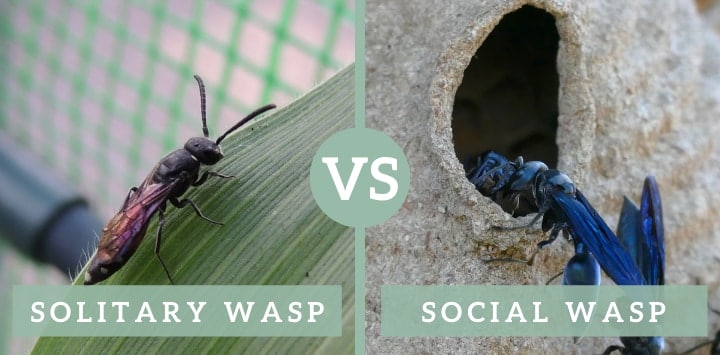
There are two main types of wasps, the solitary ones and the social ones, which nest together. Here’s a quick look at each of these.
Social Wasps
For wasps, being social does not mean that they live in large colonies–far from it. A typical wasp nest can contain only a dozen individuals. The larger wasp nests can contain as many as 10,000 individuals, way below the 50,000 workers in a bee colony.
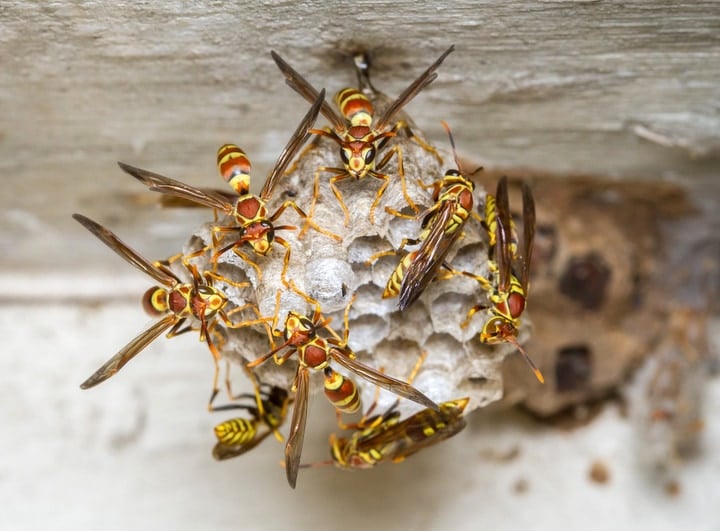
The social wasps belong to the Vespidae family, which includes the hornets and the yellow jackets, one of the most aggressive types of wasps.
Solitary Wasps
The vast majority of wasps belong to the solitary type and they are mostly predators. There are four main groups of solitary wasps:
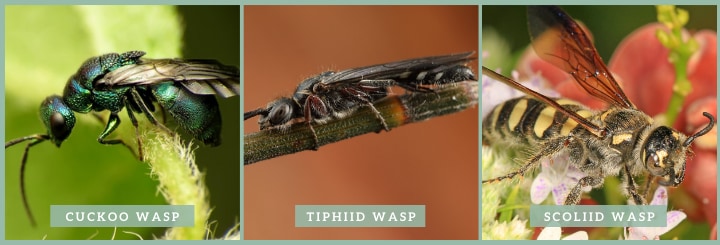
- Cuckoo wasps, which belong in the Chrysididae family
- Tiphiid wasps of the Tiphiidae family
- Scoliid wasps of the Scoliidae family
- Velvet wasps of the family Mutillidae
Solitary wasps are generally parasitic and do not build colonies, unlike their more social relatives.
All Different Wasp Types and Breeds
Now let’s look at the main types of wasps you want to know about. If you have wasps in your garden, there’s a very high chance that they fall into one of the following types or breeds.
1. Yellow Jackets
Yellow Jackets are the most common and one of the most aggressive wasp species in the US.
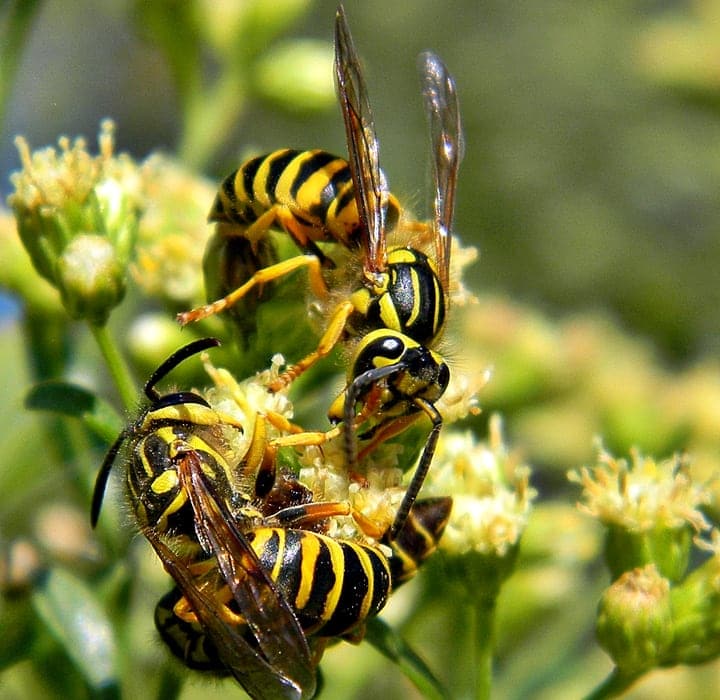
Of the 16 types of yellow jackets wasps that live in the US, most have gold and black patterns, though there are a few with white instead of yellow and some also have red markings on their bodies.
Most are the same size as regular bees, but are less hairy. They vary in lengths between 3/8 and 5/8 inches.
2. Northern Paper Wasps
They take their name from the material their nests are made of, usually regurgitated wood pulp mixed with saliva. You’ll find such nests hanging from trees.
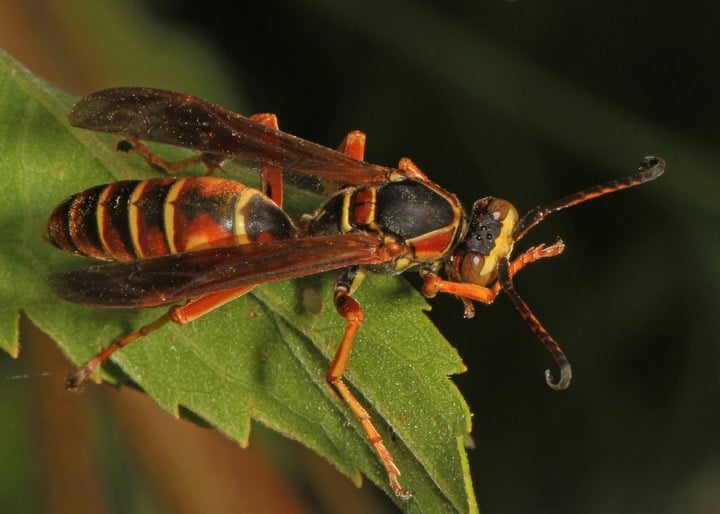
They’re brownish rather than black, with yellow or reddish markings. They have distinctive long legs, so it’s easy to tell them apart from bees or yellow jackets. Northern paper wasps are common all over the Midwestern states.
3. Mud Dauber
Mud daubers are solitary wasps with slender bodies, usually with yellow markings and yellowish wings. They take their name from the fact that they dwell in mud where they dig nests.
They often dig 1 inch tunnels side by side and deposit one egg in each of them. Mud dauber nests can be found under eaves and porch ceilings as well as in garages, barns or sheds.
4. European Hornet
This type of wasp arrived in the US in the late 1800s and is now widespread over Eastern states. They live in papery nests under porches or in hollow trees and you can find up to 400 adult wasps in a colony.
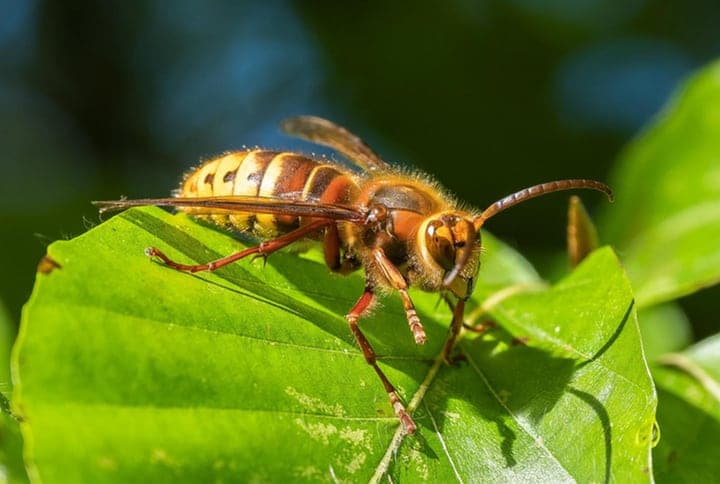
They are large intimidating insects with black heads and sometimes red markings. Their abdomens are in the typical black and yellow pattern. While they appear quite scary, they are defensive creatures and won’t attack unless threatened.
5. Bald-faced Hornet
Bald-faced hornets have a stout body, usually black and white. Their heads and upper parts of the body are black. They are extremely aggressive and will sting repeatedly if they feel their nest is in danger.
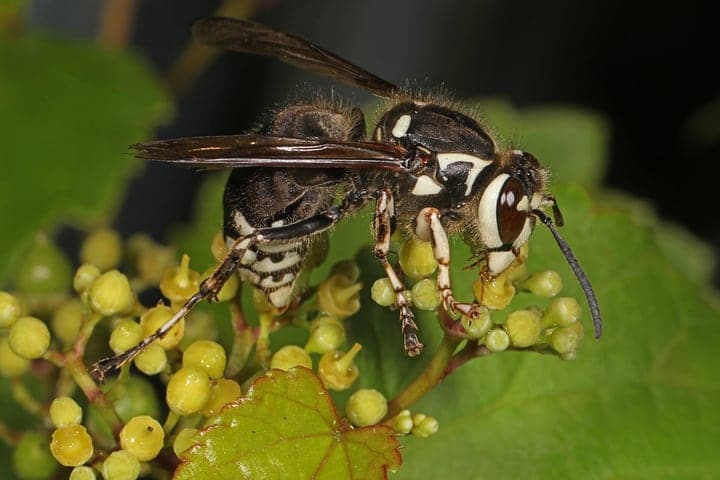
You will find a bald-faced hornet nest attached to lower branches or trees or bushes, as well as hanging from a building’s eaves.
6. Blue-winged Wasp
Don’t go around looking for a flying insect with blue wings. The truth is this species has blue-black wings and in most cases you won’t notice the blue shade. However, you can identify them by the orange abdomen and the bright yellow spots near the waist.
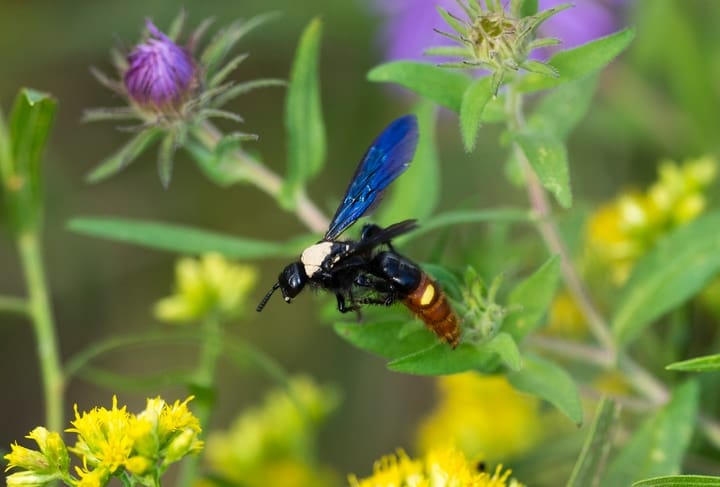
They are very good for pest control, especially against the Japanese beetle which chews its way through flower petals, destroying a garden.
7. Thread Waisted Wasp
They have an incredibly thin waist even for a wasp, which is how they got their name. They are blackish in color, with bulging red or orange abdomens.
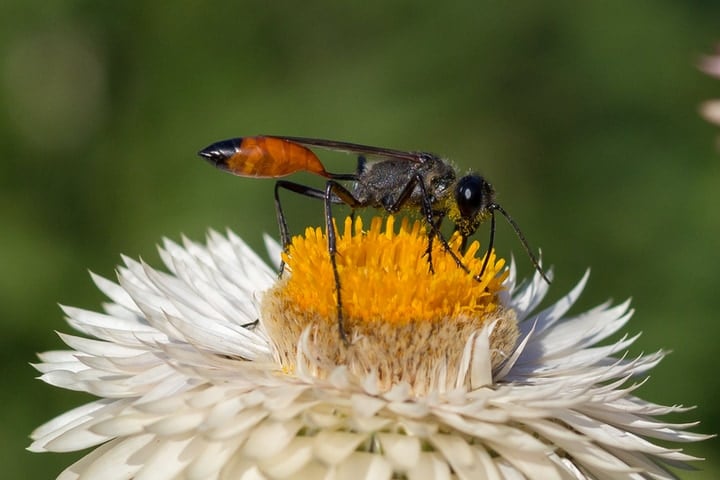
These wasps have long skinny legs which they use to grab on to a plant. They tend to live in mud nests and attack by ambushing their prey, usually small insects they paralyze with their venom and then they lay their eggs in the victim’s body.
8. Cow Killer Wasp
Also known as the Eastern Velvet ant, this one is a solitary parasitic wasp which lays its eggs in bumblebee colonies.
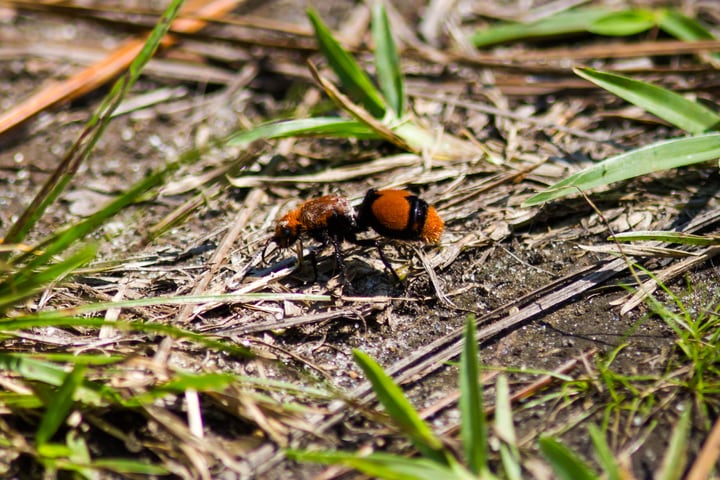
The females of the species are wingless and their sting is said to be strong enough to kill a cow.
9. European Paper Wasp
This type of paper wasp is not native to the US. European Paper wasps typically have black and yellow stripes, which makes them easy to confuse with yellow jackets. They are smaller in size than Northern Paper wasps.
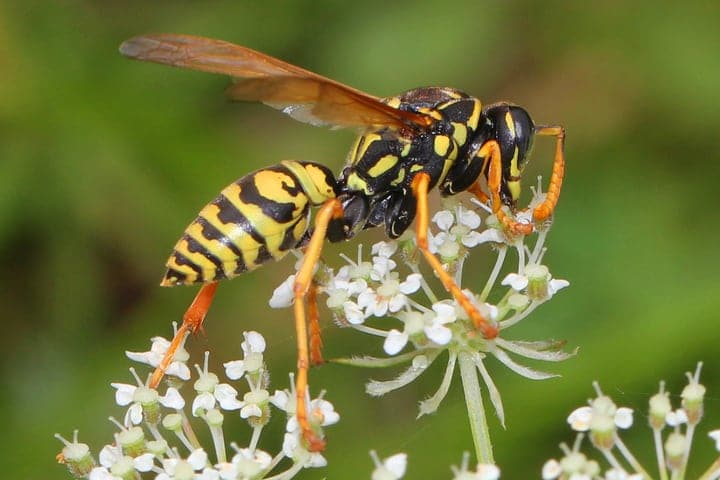
European paper wasps are great for pest control as worker wasps feed caterpillars, cabbage worms, and hornworms to the larvae.
10. German Yellow Jacket
They look very much like common yellow jackets, with the same black and yellow stripes pattern, but they can be distinguished by the spade-shaped black marks on their abdomens.
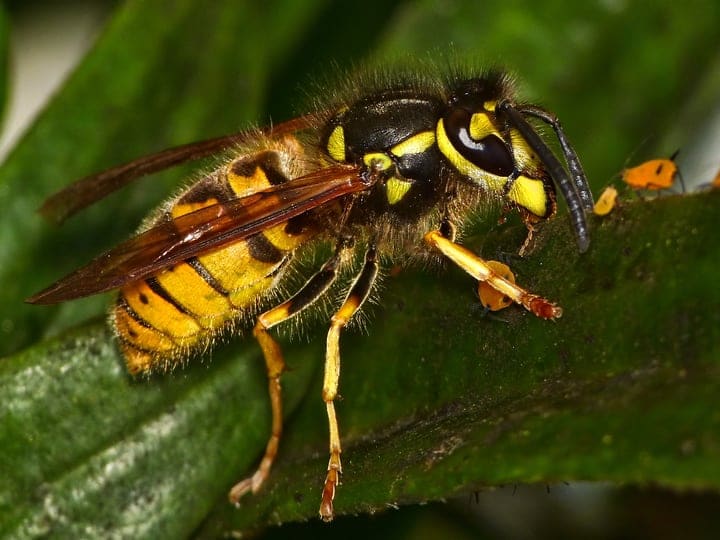
11. Spider Wasp
The name is a dead giveaway just as dead as the unfortunate spider they happen to attack and paralyze with their venom. Spider wasps have a distinct coloring with black bodies and bright orange or reddish legs.
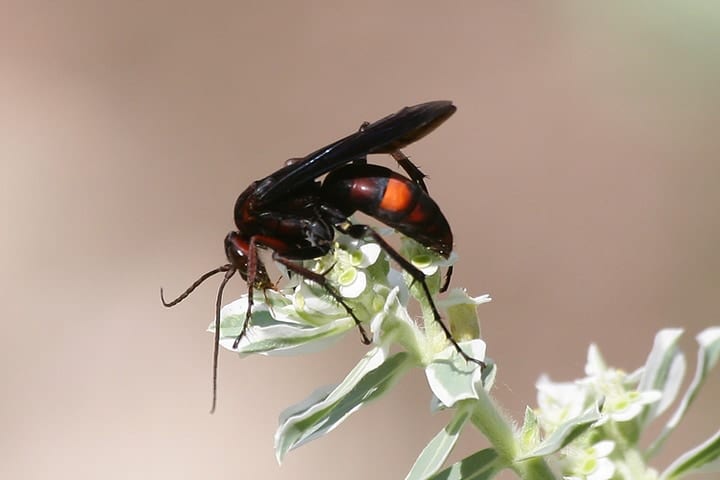
They tend to make their home in mud jugs abandoned by mud dauber wasps. These wasps are strong enough to carry a spider to their nest, where they will lay eggs near the dead bodies, providing food for the larvae once they hatch.
12. Cicada Killer Wasp
As their name says, these wasps prey on cicadas and are rarely a threat to humans. They have black bodies with yellow markings on them and they can sometimes be seen working together to build a nest, which might be mistaken for a small animal’s burrow.
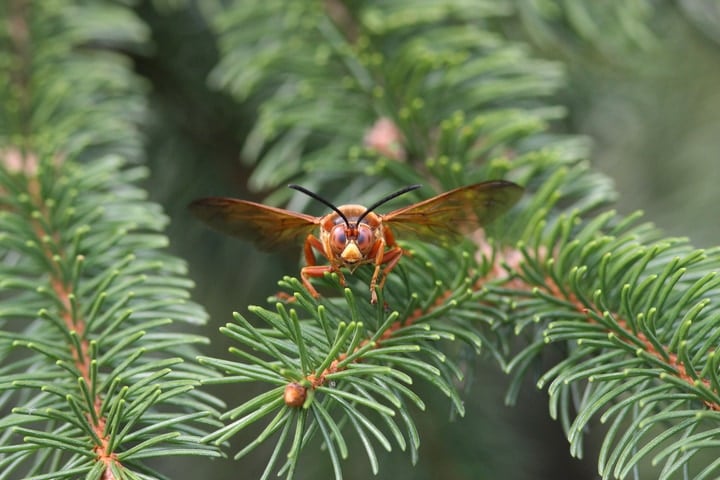
They hunt and attack cicadas in midair, paralyze them with their sting and take the bodies to their nests for the larvae to feed on.
Fact: Adult cicada killer wasps do not feed on their prey but they are attracted to flower nectar so don’t be surprised to find them in your garden.
13. Southern Yellow Jackets
These wasps have a vivid, unmistakable black and yellow pattern. They are very aggressive not only towards humans, but also other yellow jackets species and won’t hesitate to invade the nest of weaker species.
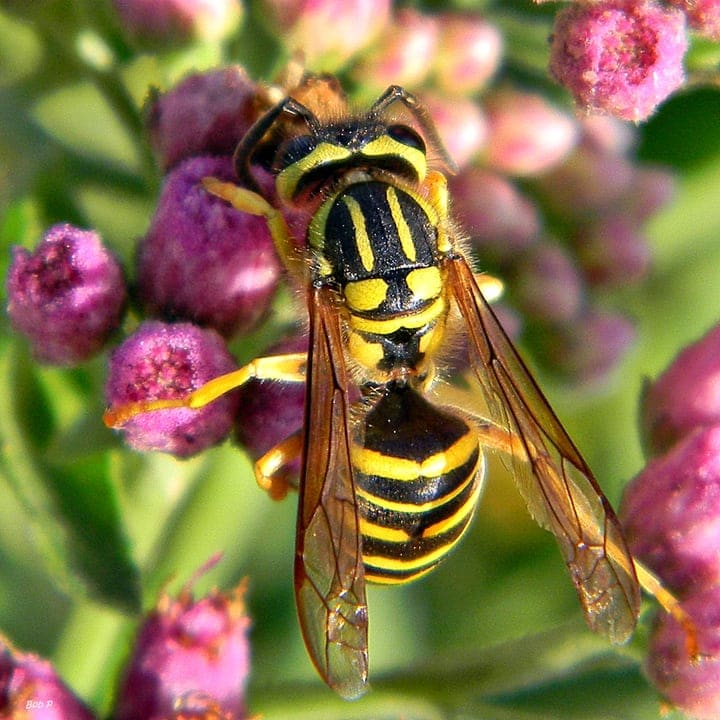
Once they have a home they will defend it ferociously. With their spade-like stinger they can attack multiple times before dying.
14. Braconid Wasps
These wasps are very small and can easily be mistaken for flies. They have black heads and red bodies. Their wings, legs, and antennae are also black.
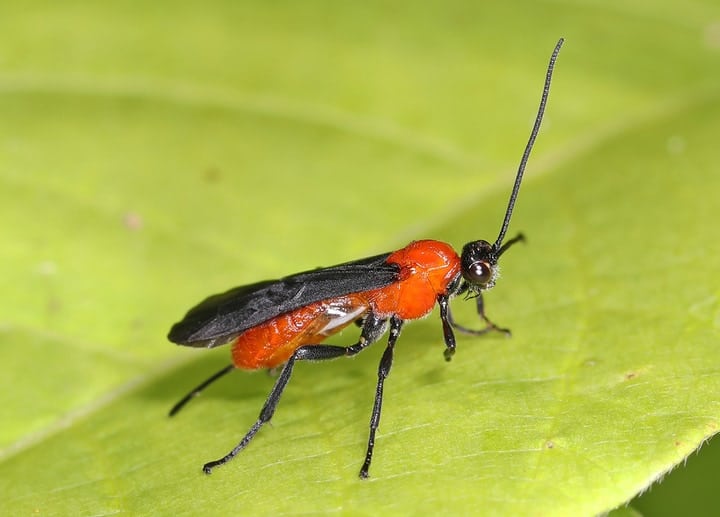
Braconid wasps have a long needle which looks like a stinger, but it’s not. Through it, they manage to deposit eggs deep inside holes in trees to protect them from predators.
15. Potter Wasps
These are solitary insects and their main hobby is killing caterpillars, so their presence might be beneficial for your garden. They’re mostly black with a yellow band above the thorax and another one on the abdomen.
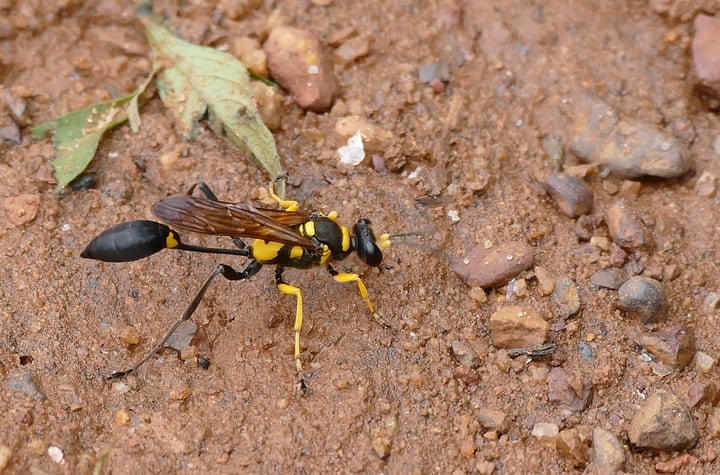
They don’t bother to build nests and prefer abandoned ones. Once they find a new home they will hunt down a caterpillar, paralyze it and take it to the nest where they lay their eggs.
Once the eggs hatch the larvae will feed on the caterpillar until they’re big enough to fly.
16. Cuckoo Wasps
This type of wasp is easy to identify by the distinctive green metallic color of its body, while their wings and legs are black. They are small in size and take their name from the fact that they lay their eggs in the nests of other bees.
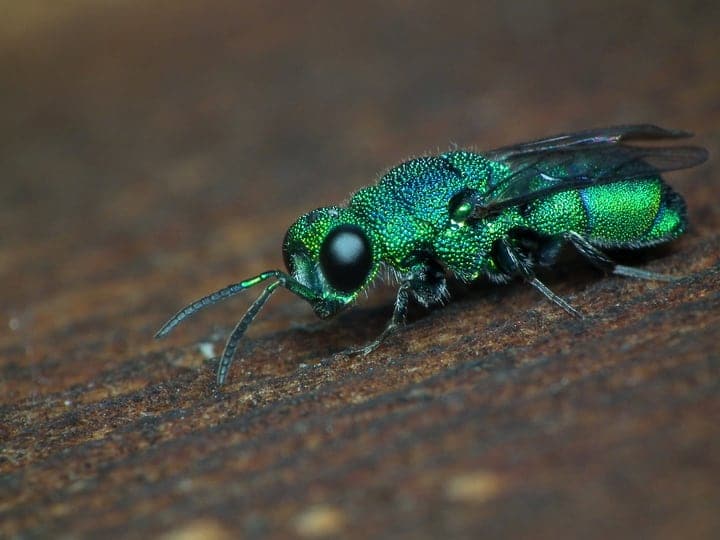
They are not very aggressive as a species and they have rather small stingers. Once a cuckoo wasp feels cornered, rather than attack desperately like other wasps, it will curl up and hope for the best.
17. Four-toothed Mason Wasp
It’s very similar to the Bald-faced wasp, and takes its name from the protruding mouth parts which resemble teeth.
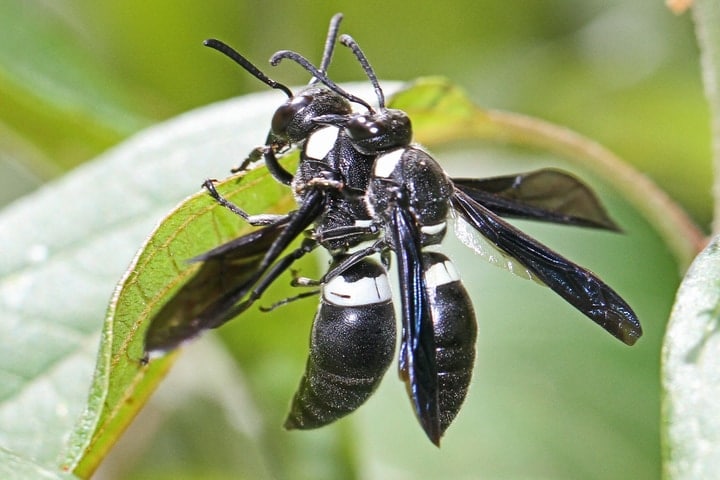
As far as other types of wasps go, these are very small, with black hairless bodies. You can easily recognize them by the white markings on their back. These wasps hunt caterpillars and moths to feed to their larvae.
18. Great Black Wasp
These are part of the larger Digger wasp family and they mostly live in burrows. They are larger than other wasps and can be recognized by their shiny black bodies with a bluish shade.
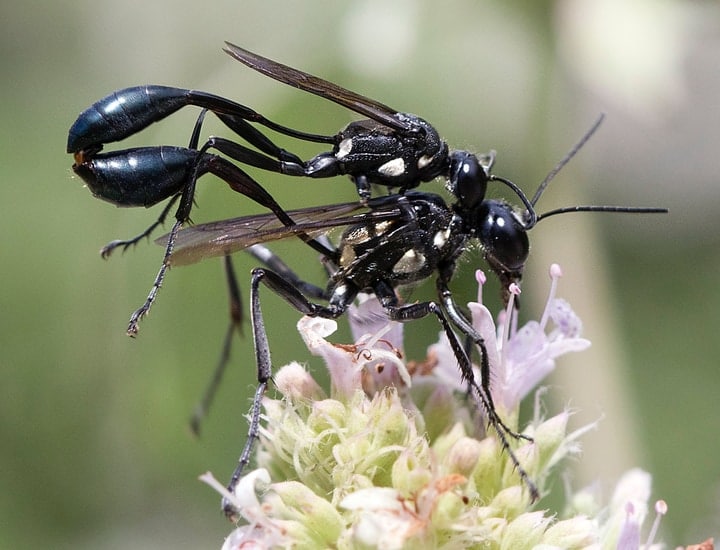
They are not as dangerous as they seem as they rarely attack humans. Unlike other wasps, they actually do some pollinating work while feeding and they’re great as pest removers.
19. Horntail Wasp
Mean-looking insects with a jet-black body and brownish wings. Females of the species appear to have a fearsome stinger, but the fear-inducing syringe is actually what they use to lay their eggs.
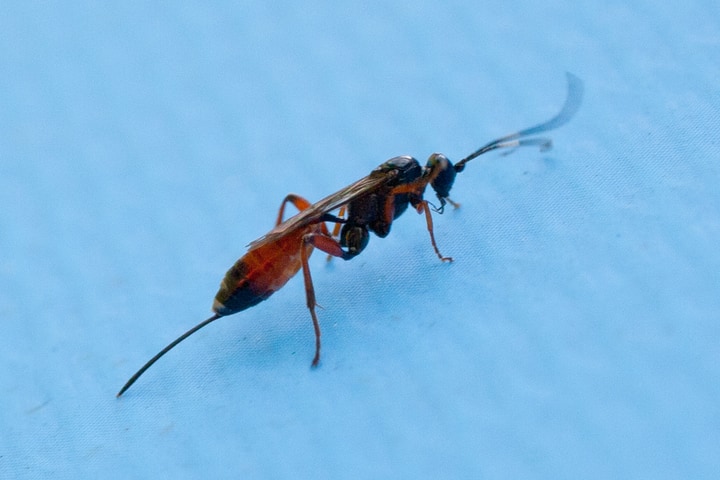
They like to inject the eggs deep inside tree trunks where the larvae will remain until they become adults.
Types of Wasps in Different States
The types of wasps you’re more likely to meet depends on the weather pattern in your area, as some of them prefer a Northern temperate climate, while others thrive in warm and humid conditions.
Wasps in Florida
- Cicada Killer Wasp
- Paper Wasp
- Southern Yellow Jackets
Wasps in Texas
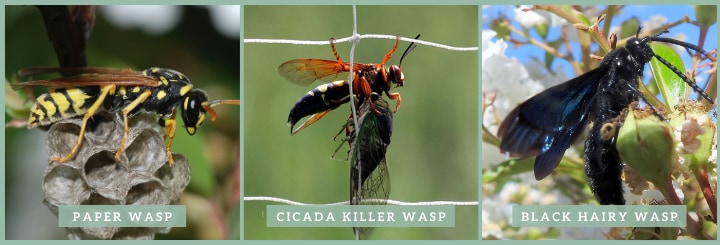
- Paper wasps
- Cicada Killer Wasp
- Great Black Hairy Wasp
Wasps in California
- Bald-faced Hornet
- Paper wasps
- Mud daubers
- Yellow Jackets
Wasps in Michigan
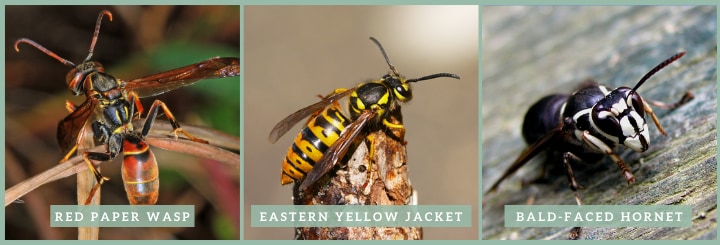
- Paper wasp
- Yellow jackets
- Bald-faced hornets
Wasps in Virginia
- Bald-faced Hornet
- Paper wasp
- Yellow jacket
- European Hornet
- Mud dauber
Wasps in New York
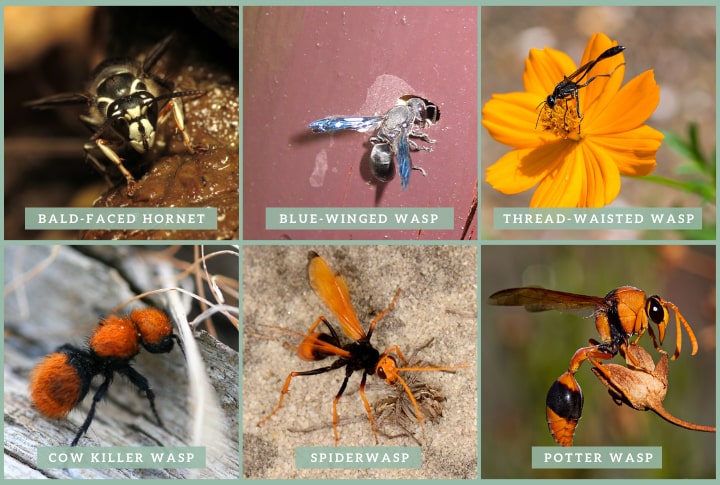
- Bald-faced hornet
- Blue-winged wasp
- Common Thread Waisted Wasp
- Cow Killer Wasp
- Spider Wasp
- Potter wasp
Wasps in North Carolina
- European paper wasp
- Cuckoo Wasp
- Four-toothed Mason Wasp
- German yellow jacket
How to Identify a Wasp
With so many different species buzzing around, it’s impossible to tell wasps apart by size.

Some of them are very small, less than half an inch, while others are really big and scary, like the Asian giant hornets who grow up to 1.6 inches, with the queen being even larger.
There are, however, some physical traits that will allow you to tell wasps from bees.
Waist
Most wasps species have a slim waistline, unlike bees. This is because a wasp’s abdomen narrows down at the upper part where it meets the thorax.
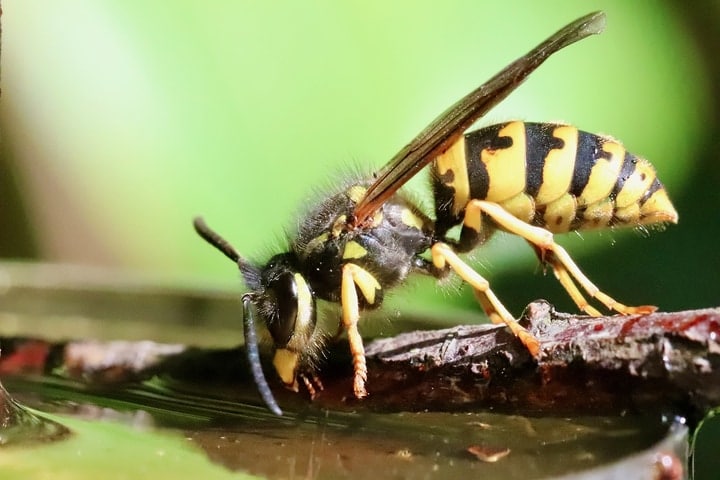
There is one exception to the rule–hornets do not have a thin waist, so they may be mistaken for bees.
Hair
Most wasps are less hairy than bees and this is because they are not primarily pollinators like bees.
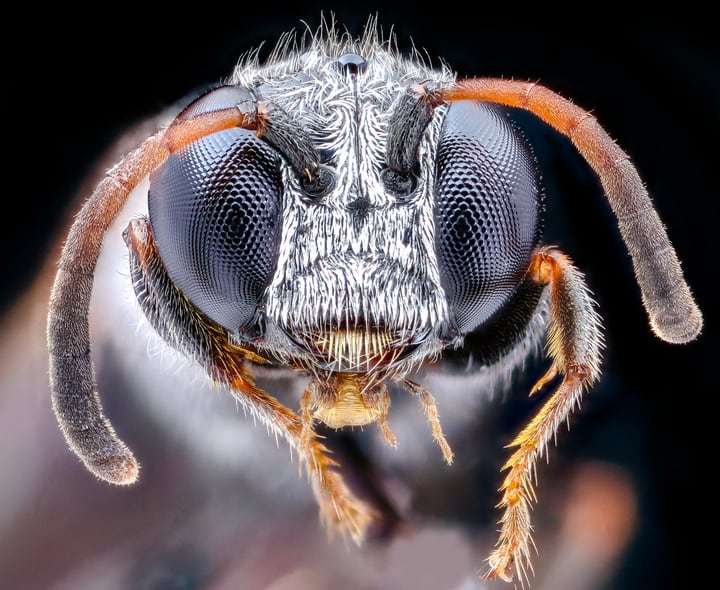
When bees fly around from one flower to another, they use their body hair to collect pollen which is stored on little baskets attached to their legs.
For the most part, wasps don’t bother with pollen, hence they don’t need little hairs.
Frequently Asked Questions on Wasp Types
Wasps usually don’t get the good press that bees get. But we still hear people asking a lot of questions about them. Here are a few of the most common questions with answers on different types of wasps.
What types of wasps are there?
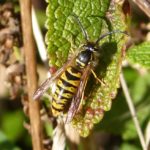
There are primarily two types of wasps, the solitary type and the social type. For most people, the social wasps are more important as you’re more likely to meet one that has a nest somewhere around your garden, under the roof, or in the attic.
Which wasps are most aggressive?
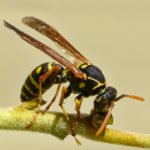
Yellow jackets are considered extremely aggressive and the biggest danger they pose is that they can sting multiple times.
While honey bees have a barbed stinger that gets stuck once it stings you, yellow jackets have a lance-like stinger which they can easily pull out.
This means that if you run into a yellow jacket it might attack multiple times, doing considerable damage.
What is the most common wasp?
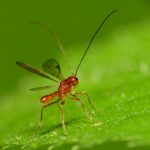
Across the United States, yellow jackets are one of the most common species of wasps you might have problems with.
Other very common species are paper wasps, mud daubers, ground wasps, and the so-called red wasps.
What kind of wasps are black?
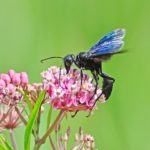
The great black wasp goes by the scientific name of Sphex pensylvanicus, which should not fool you–they don’t live only in Pennsylvania.
You can find the black wasp in many parts of the US, on the east coast as well as on the west coast, where the warm weather conditions allow it to be active all year round.
Great black wasps are up to 1.3 inches in length and do not have stripes or other markings on their bodies. Learn more about the wasps by state.
Don’t Mess with Wasps
Wasps are rarely more dangerous than bees and will generally leave humans alone if the latter leave them be as well. Of the thousands of wasps species in the US, you’re more likely to cross paths with some type of yellow jacket wasp or maybe a hornet.
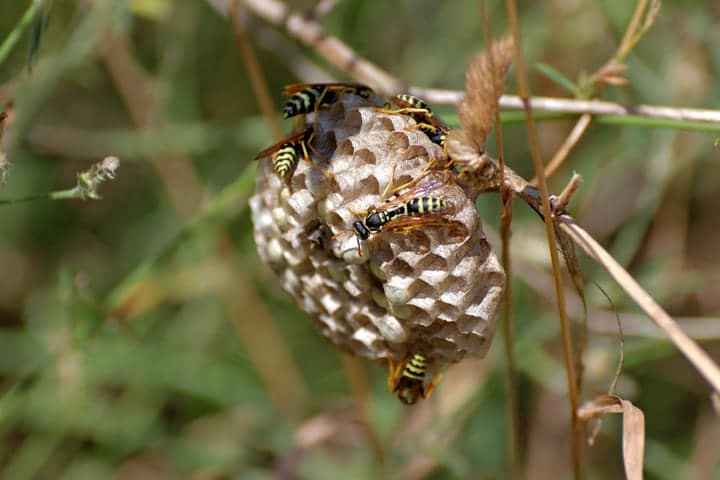
The most important thing to remember is to give a wasp nest a large berth. Identifying the exact type of wasp is just an interesting fact, but it won’t help much as all wasps will defend their home viciously.
Now that you’ve read about the different types of wasps, which do you find the most interesting? Drop us a comment and let us know.
We’d love to hear from you!
And don’t forget to check related posts on beekeeping and bee houses.
See you next post!

Thank youaoersonhere around Yelm WA was askig aouta wasp she killed.i was curious what ine it was. Couldn’t find it here but found useful information.
Hers was blackeith a few light markings. Long legs and what looked like a stinger but may have only been for laying eggs.
Thank you again.
Thanks for all the info about wasps.There are a few near my house going in and out of a hole that they have made. in a mud hole.I’m not that concerned now that I read your facts.I hesitate to refill the hole as to not harm them.